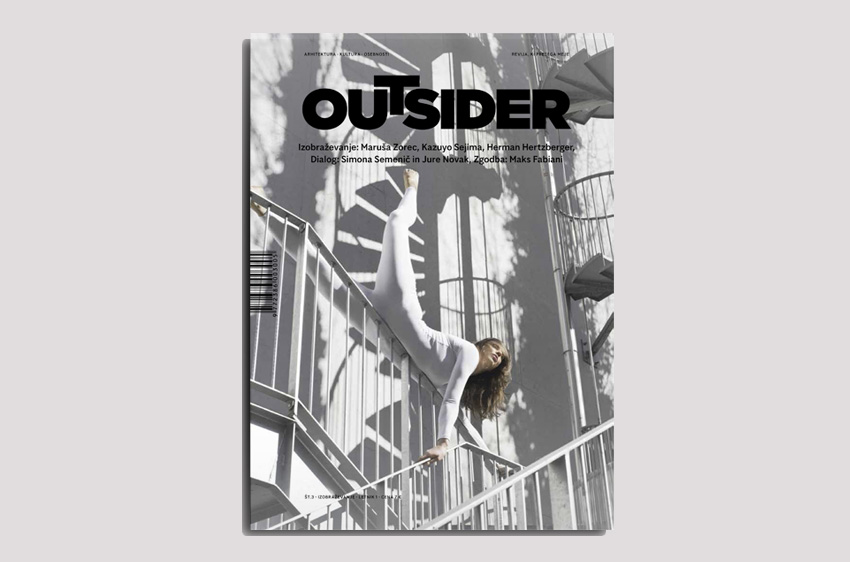Text: Matevž Granda ~ Outsider Magazine
The media has been absolutely abuzz, lately, due to the fascinating scenes in Anja Humljan’s book, The Urban Yoga. The photography portrays Anja in creative yoga positions, using elements of urban infrastructure as props. This includes everything from a basketball hoop, the crossbar of a goal, a traffic light, stairs, pillars, the gallery at a marketplace, a house’s cornerstone, a bathroom, or even the mantle of a fireplace. Anja Humljan finds her space where no one was even looking for it before.
Since she is an architect, she is shown in her natural habitat, as it is hard to imagine a better way to forge a connection with architecture than directly with your own body. Her white workout bodysuit has become her signature. The purity of stillness in immaculate architectural compositions brings to mind the perfection of ancient sculpture, which speaks to the anthropocentric foundations of our civilization. The most well-known among them are the caryatids of the Erechtheion on the Athenian acropolis (406 BCE), the oldest of which are from the 6th century before the Common Era.

Vitruvius theorized about the origin and meaning of the caryatids, but his speculations have been proven as inaccurate. According to him, they represented punished and enslaved Athenian women who defected to the Persians during the wars between them and Athens. The problem with this theory is that the earliest caryatids appeared before these wars, although for the current record this is unimportant. In modern history the caryatids began to appear again as a decorative element on fireplaces in Renaissance Italy. Mannerism again sees them on palatial facades, while during the Baroque period they took on an entirely new meaning in architectural expression, and classicism returns them to their ancient origins.
At the end of the 19th century, caryatids positively flourished in neoclassical Vienna. If the classical caryatids were withdrawn and responsible for supporting the load they carried, the Viennese caryatids were charged with sexual energy. At the end of the 19th century, Vienna was one of the largest and wealthiest metropolises on earth, with its riches concentrated in the center of the city. The areas on the city’s outskirts were meanwhile settled by the hope of the poorer classes, the hope that they would one day be able to cross the invisible line separating them from a carefree life and abundance. They were willing to do anything for this. Pretty young girls, for instance, would support themselves by posing for artists, who would immortalize their bodies into the stone walls of wealthy palaces in the heart of the city. Poor, impoverished eastern European girls from Vienna’s outskirts became the city’s caryatids and, via the inspiration of its artists, secured themselves an eternal memory in the glitz of the metropolis.

In 1908, Adolf Loos declared the ornament to be a crime. The caryatids became outsiders, as modernism no longer needed them. Le Corbusier’s Modulor finally set them free. Anja Humljan’s work can be understood as an independent caryatid, faithful only to architecture itself, a maverick caryatid that makes its own rules. This caryatid no longer needs an artist, for she is an artist herself. In the context of modern architecture, freed from decor, dictated by functionalism, and often technically dehumanized, The Urban Yoga is a contemplative inquest into the aesthetics of architecture, the measure of humanity, and the depths of our soul. It is that lost fascination with architecture that transcends the anthropocentric measure of functionalism.
Translation from Slovene: Josh Rocchio
Welcome to read more in The Urban Yoga book. All proceeds from the books are used for further research and production costs for The Urban Yoga project. In such way the research can remain entirely independent and transparent continuing to grow in a way that remains focused on inspiring people to look at the magic of urban space, finding their balance and inner peace, not only on their yoga mats, but also on the streets of our buzzing cities. With the continued support of all urban yogis, we are breathing new human-oriented life into the efficient and industrial world of urban architecture and design. Thanks to everyone for your continued support.